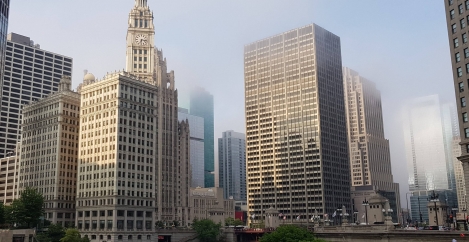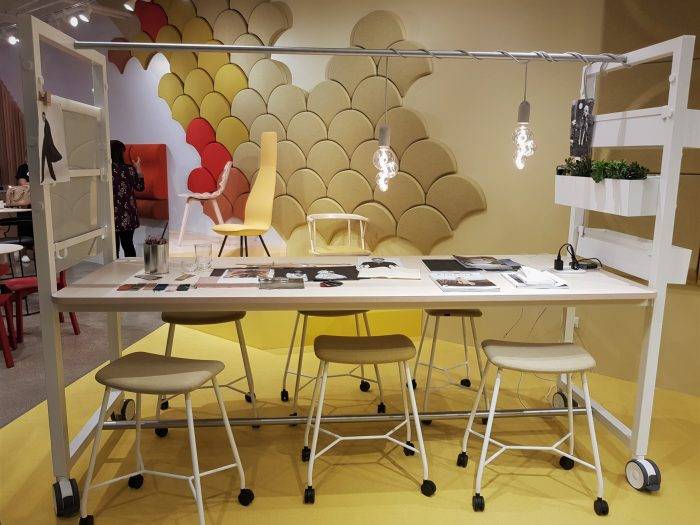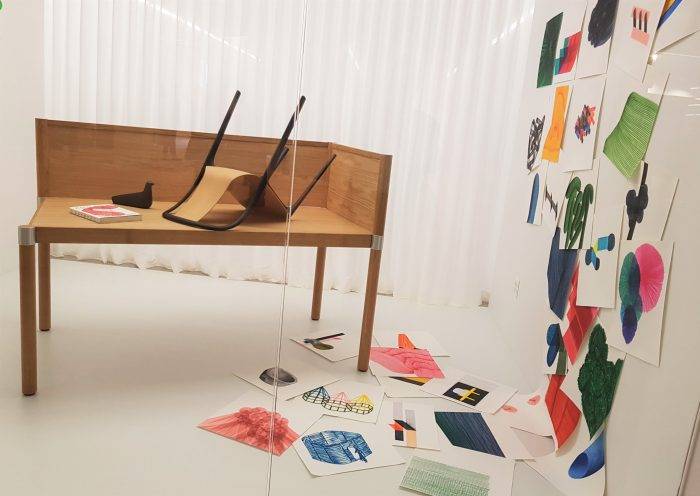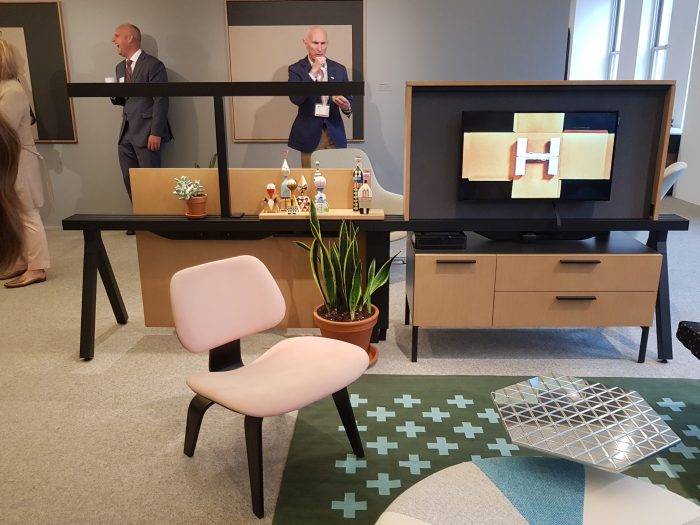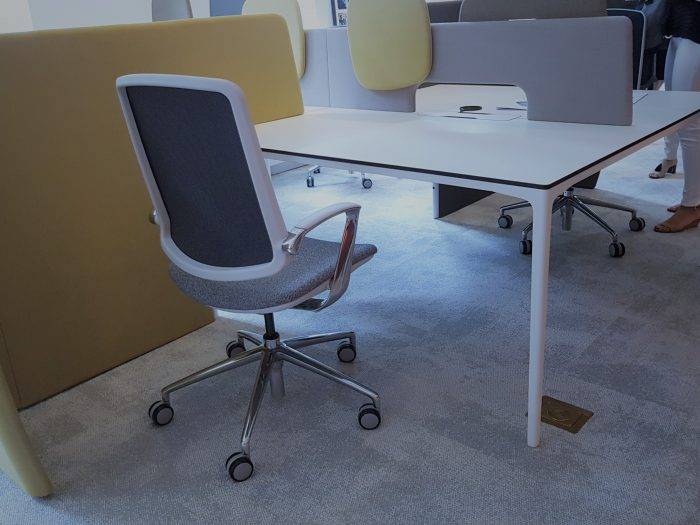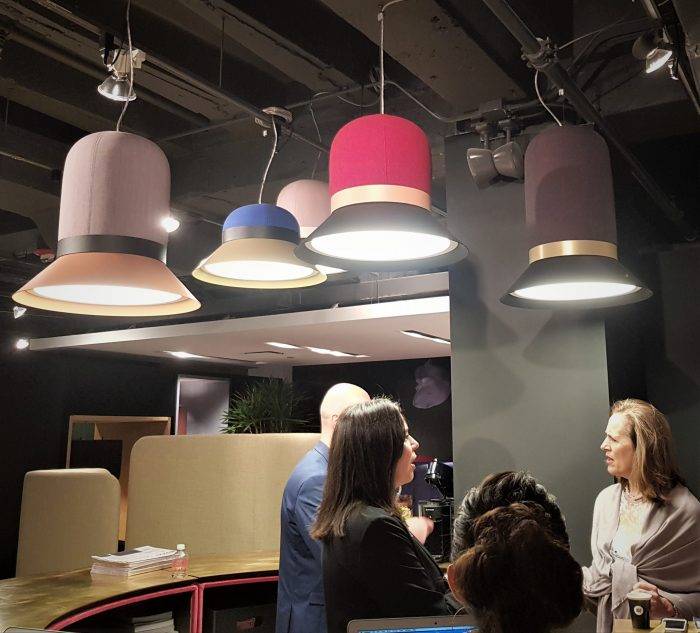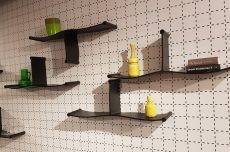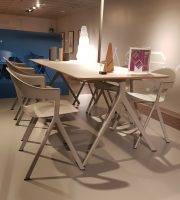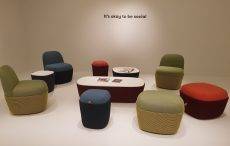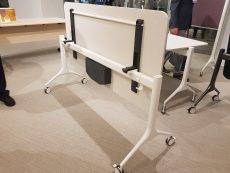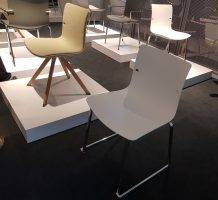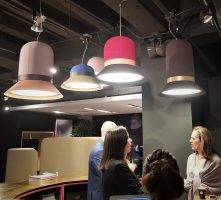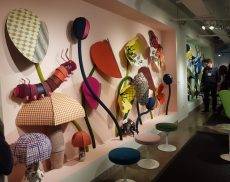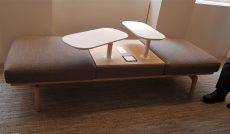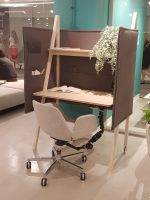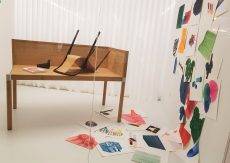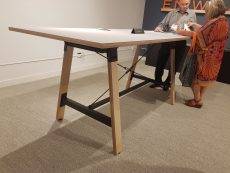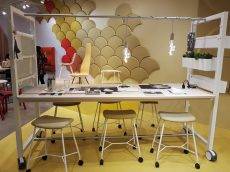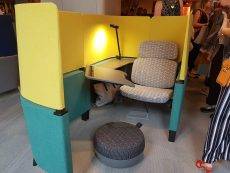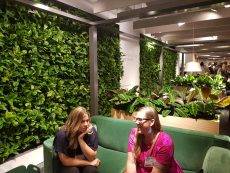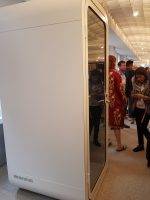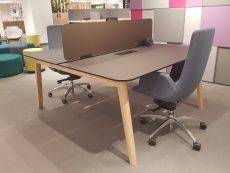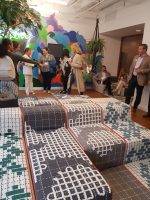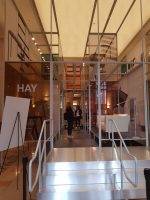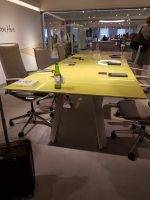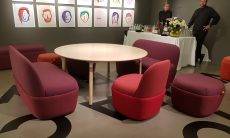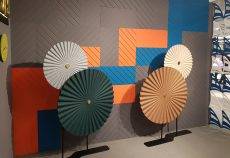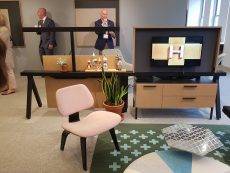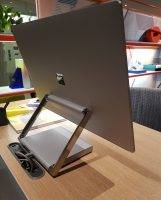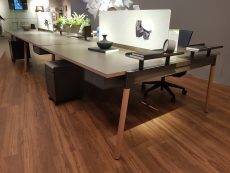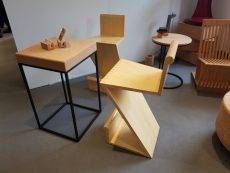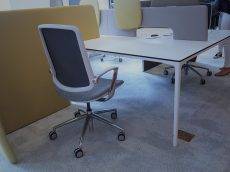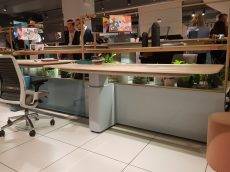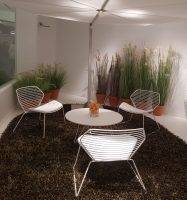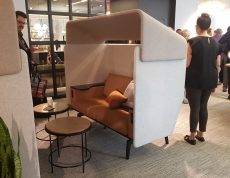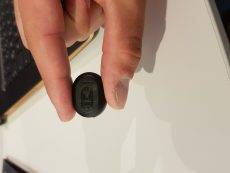June 21, 2018
The future of the workplace emerges from the mists at Neocon
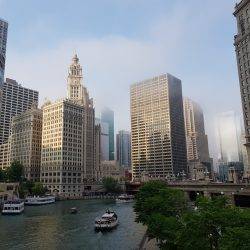 Chicago is one of the world’s great cities. Its dramatic lake and river setting, its magnificent architecture and its raw energy inspire the locals and businesses to achieve great things. People work and play very hard. Competition is fierce both in business as in the way the people relate to each other, and befits a city heavily influenced by waves of immigration down the ages. Apart from somewhat overly aggressive and noisy driving, if there is friction, you don’t sense it and it isn’t obvious. Most locals seem genuinely open and friendly, including to strangers, and happy to get on with their lives without troubling others. Perhaps they’re all being buoyed up by the great street music which is everywhere.
Chicago is one of the world’s great cities. Its dramatic lake and river setting, its magnificent architecture and its raw energy inspire the locals and businesses to achieve great things. People work and play very hard. Competition is fierce both in business as in the way the people relate to each other, and befits a city heavily influenced by waves of immigration down the ages. Apart from somewhat overly aggressive and noisy driving, if there is friction, you don’t sense it and it isn’t obvious. Most locals seem genuinely open and friendly, including to strangers, and happy to get on with their lives without troubling others. Perhaps they’re all being buoyed up by the great street music which is everywhere.
The city’s weather however would test the patience of a saint. It runs to extremes, at least so it seems for those from temperate climes. Hot and humid summers and very harsh winters do their best to stress out a Chicagoan’s famously good humour. Unusually this year, visitors to Neocon weren’t treated to endless days of blue sky and unbroken sunshine and balmy summer evenings. Only those stalwarts who stayed over until Wednesday were able to enjoy fine weather; the rest of the crowds who left in their droves on Tuesday evening or even earlier, experienced miserably dull drizzle and positively chilly temperatures.
The Show
The show was great on so many levels. There seemed to be many more visitors than in recent years and the atmosphere was brilliant. Noisy, crowded to extremes, pushing and shoving, laughter, and banter of old friends bumping into each other, a year after they’d last met. Officially, the show opens on Monday and closes on Wednesday but increasingly, Sunday has become busier and busier with previews and VIP presentations as well as parties in the evening. The tempo, day and night, continued frenetically until Tuesday, after which, judging by the almost empty showrooms, corridors and elevators on Wednesday, everyone had collapsed somewhere in a heap.
This was the 50th Neocon and if the enthusiasm of exhibitors and visitors alike is anything to go by, it seems well set for the next 50.
Changes last year restricted the temporary show space so that it is now housed only on floor seven. That area was much improved this year, and the high demand for the space allowed the organisers to be selective, raising the exhibitor standards and improving the visitor experience. The heart of the show remains, however, the permanent showrooms on the three main floors – 3, 10 and 11, especially 3, where most of the space is taken up by the massive showrooms of Steelcase, Herman Miller, Haworth and the HNI companies. This year, Steelcase had further expanded their showroom space with several new areas, including the WorkCafé which used products from the Steelcase, Coalesse and Turnstone brands, as well as independent partners, and came together to create informal spaces to support people when they need to collaborate, socialise, focus or rejuvenate.
Scandinavian Spaces was a colourful and attractive newcomer, bringing together nine well known design companies, mainly from Sweden, including Blå Station, Nordgröna and Götessons.
The front entrance area of the Mart, occupied in recent years by Herman Miller, was this year given over to the Danish company, Hay, in which Miller acquired a 1/3 stake earlier this month.
Environmental issues were well in evidence with Knoll, and their very large showroom, which they are reportedly planning to vacate before next year’s Neocon, was dominated by a massive living wall. They also presented their Full Circle environmental programme where they work with global clients to reduce landfill.
Trends
After various recent shows in Europe, it wasn’t at all surprising that this Neocon also had an overwhelmingly residential feel to it. So much of life today is to do with breaking down barriers so why shouldn’t that apply to the differences between work and home? Materials – even the artificial materials such as laminates and metals – had a natural look. Out were blacks, whites and silvers; in came wood and muted browns and greens and greys of the forest. Nordic designs are increasingly admired and appreciated here and many companies from the region are beginning to exert some serious influence on the market, both as businesses in their own right and piggybacking some of the largest North American companies. SitStand tables that dominated the show last year had retreated somewhat and didn’t take pride of place to the same extent. Rather, the emphasis was on colours, finishes and textiles used to create a feeling of seamlessness between home and office.
Some highlights (full gallery at bottom of page)
Knoll’s striking Atmosphere Collection of wall treatments by Dorothy Cosonas won a Gold Award and attracted attention. The allseating showroom was in the 325 North Wells St building across the street from the Mart where they launched the Zinc chair in a variety of configurations from Carl Gustav Magnusson.
Inscape, from Ontario, followed the wood theme with their new RockIt bench system which had a very clever simple system of attaching screens, plant boxes and other accessories by clicking them into toolbars. Also looking very “woody” were Vitra whose small showroom was light, airy and slightly idiosyncratic.
Another environmental story was told by architect and furniture design firm, Eugene Stoltzfus, who create their furniture from moso bamboo and solid Portuguese cork. Inspired by the vision of Gerrit Rietveld’s iconic Zig Zag chair, they showed the Zee Counter Stool which needs no blocking, plates, or pins.
Continuing the environmental theme, Burgeree from Shanghai printed patterns and logos onto compressed PET sheeting to create acoustic wall cladding and space dividers.
The studio tk division of Teknion continues to expand its reach and grab more showroom space. Their soft seating was particularly attractive, as was their Cesto line from Netherlands based designer Khodi Feiz
Herman Miller’s space was vast and crowded. Amongst a wide range of new products, the new partnership with the Finnish company, Framery, allowed them to show a range of soundproof cabins and Canvas Vista designed by Joey Ruiter created an attractive workstation and space division system.
Haworth’s showroom looked very different from last year. Their Wellbeing theme, which was presented in a number of showrooms under different names, used original fabrics and lots of natural wood to create some stimulating environments. They also featured the Haworth Collection of lifestyle designs from a wide range of international designers and companies with which Haworth and their dealers are content to work. They include Janus et Cie, Pablo Designs and, interestingly, as with Herman Miller, Framery.
The Mackinac Collection from Steelcase combined an elegant electrically powered sitstand table cantilevered off a massive, powered, base and one of the many open shelving systems seen at the show, this time in inch-steel section. Another innovation was the way Steelcase worked with Microsoft to combine a PC and monitor with the simplest of simple, elegant, pivoting and height adjustable stands.
Steelcase has also further developed the Brody enclosure concept based on airlines’ business class seating using a wide range of finishes and accessories.
One company that never disappoints is Davis whose business model is to scour the world for beautifully designed furniture which they then manufactures under licence in North Carolina. This year, they launched Gingko indoor/outdoor furniture from Jens +Laub.
Boss Group from the UK won a Gold award for their Simon Pengelly designed Atom range, as did Okamura for their Traverse Satellite table system designed by Susan Grossinger. Another UK company, Allermuir, part of Senator Group, showed their new Axyl side seating designed by Benjamin Hubert of Layer.
Interstuhl, the largest German office chair company, working with Garmin, have created an app controlled system, S4.0, for office workers to monitor and improve their seating time. An electronic, rechargeable, button under a task chair measures the chair’s motion and checks and records the extent and the way they move on the chair to match against pre-set goals.
One of Europe’s fastest growing companies, Narbutas from Lithuania, were in Chicago for the first time. Using several international designers, their products seemed to fit naturally with the styles coming from the better known European companies.
The only company at the show from Turkey, Koleksiyon from Istanbul, presented a wide range of breakout furniture including enclosures.
Nucraft showed their new Myne training and presentation tables providing a clever solution to a common problem. Because these tables are always on the move, they can’t easily be left plugged into power sockets. So how can the tables’ USB ports be relied upon to charge phones and tablets? Myne tables link the ports to a removable and rechargeable battery stored under the table; the port has a series of indicator lights to show when the battery will next need charging.
Enwork from Lowell, Michigan, started life in the proverbial basement fifteen years ago. This year they launched the Adventure Table in various heights and configurations.
Buzzi were as fun and quirky as always with a new range of lighting – BuzziHats – and BuzziSpark, a re-arrangeable seating system designed to start or cease communication.
The OFS showroom had been re-jigged and their products were following the trend of residential styled furnishings. Their acoustic enclosures and the Custom banquette bench attracted attention
….and finally
– The Steelcase showroom stole the show with its size, style, innovation and demonstration of industry leadership
– Neocon is alive and well – although it needs a proper third day, which would spread the load for visitors and exhibitors alike. Monday and Tuesday are so jam-packed that it’s very difficult to move around, let alone to really appreciate the often excellent product and conceptual presentations.
_________________________________________
 John Sacks is a chartered accountant, with a degree in Law from the University of London, and over 40 years experience managing office furniture manufacturing companies in Europe. Now Managing Partner in JSA Consultancy Services, a business consultancy based in London which helps international office and contract furniture companies with their corporate strategy, marketing and product design and development. www.jsacs.com
John Sacks is a chartered accountant, with a degree in Law from the University of London, and over 40 years experience managing office furniture manufacturing companies in Europe. Now Managing Partner in JSA Consultancy Services, a business consultancy based in London which helps international office and contract furniture companies with their corporate strategy, marketing and product design and development. www.jsacs.com
_________________________________________
- Haworth Collection
- Allermuir Azxyl
- Cesto for TK Studio
- Nucraft Myne Table
- Zinc from Allseating
- Buzzi Hats
- Knoll Atmosphere Collection
- OFS Custon banquette
- Koleksiyon A Frame
- Vitra
- Enwork Adventure Table
- Scandinavian Spaces
- Steelcase Brody
- Knoll Living Wall
- Framery at Herman Miller
- Narbutas workstation
- Haworth Wellbeing
- Hay at Neocon
- Traverse from Okamura
- Studio tk
- Burgeree acoustic panels
- Canvas Vista for Herman Miller
- Steelcase Monitor stand
- RockIt bench
- Zee Counter Stool
- Atom from Boss
- The Mackinac Collection from Steelcase
- Davis Ginkgo
- OFS enclosure
- Interstuhl button




